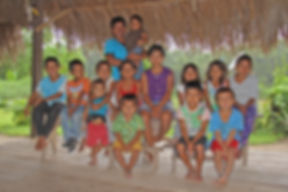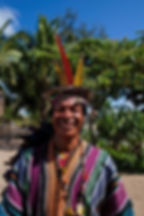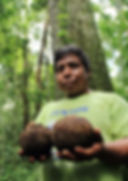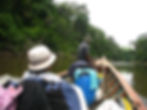
COMMUNITY DEVELOPMENT & ENVIRONMENTAL EDUCATION TEAM
Boca Pariamanu. Filadelfia. Santa Teresita. La Victoria.
Infierno. Puerto Nuevo. Baltimore. Isuyama.
Volunteer and Internship Opportunities
* All training provided *
Helping native communities and rural mestizo populations identify and implement their own long-term, sustainable development goals, with an eye to safeguarding livelihoods, cultures, and biodiversity
Spanish language abilities recommended
Team Objectives
The Community Development and Environmental Education Team work hand-in-hand with multiple native and mestizo communities in the Madre de Dios region of Peru, that together manage more than 50,000 hectares of lowland tropical forest, helping community members implement their long-term development goals. These goals are laid out in community-specific development plans with 5 year implementation periods and cover themes such as education, health, management of natural resources, transport and communication, ecotourism, community decision-making processes, community infrastructure (e.g. piped water, electricity, building projects), and events. Volunteers and interns work closely with our community development coordinators undertaking numerous and varied activities, spending 80% of their time in one or more communities, with the remaining 20% of their time in Puerto Maldonado or one of our field training sites preparing material and planning for the community stays.

A child in one of the communities showing off his catch (a fish known as a Palometa, a type of vegetarian piranha) from the community fish pond. Photo: Jesus Alferes

Fauna Forever intern sharing a few laughs with a community member from the Puerto Nuevo Native Community on the Las Piedras River. Photo: Juan Carlos Huayllapuma
Community-focussed Activities
The team's activities, which are related to community development plans, are very varied and can include: (1) Assisting with environmental education needs in the community school; (2) Mapping the population size and distribution of non-timber forest products and other natural resource assets, and monitoring change in these assets over time, as inputs into sustainable management plans and decision-making processes regarding economic activities within community forests; (3) Joining families as they plan and subsequently undertake trips to harvest non-timber forest products from community forests, such as Brazil nuts, palm leaves for thatching, and medicinal plants, including monitoring the volume of harvested products from different areas of these forests; (4) Accompanying families on short trips to gather agricultural crops from their personal plots near the central village, such as maize, bananas, papayas, cacao and so forth; (5) Preparing interpretation material and trail signage for forest trails in those communities where ecotourism activities are common; (6) Accompanying community monitoring officers as they interview community members and when they undertake periodic environmental monitoring trips around the borders of community lands; (7) Assisting with updating community development plans, which will include helping to take notes during community meetings; (8) Promoting transparent, gender-inclusive decision-making processes within communities, while also respecting cultural norms and valuing all opinions made; (9) Identifying opportunities in terms of external funding for implementing components of community development plans, such as from Peruvian government agencies and non-profit organisations in Peru and abroad, as well as potential new, untapped markets for their sustainably-harvested forest products (Brazil nuts, cacao, coffee, etc.); (9) Assist communities and families understand Peruvian law, so that they can best take advantage of opportunities without generating problems for themselves in the future as their set of activities grow; (10) Helping the team coordinator prepare material for annual reports and presentations to be given to communities and project donors; to name but a few of the activities. Note that a good knowledge of Spanish is highly recommended for volunteers and interns who assist this project, as this will allow them to communicate with and participate more freely during community activities.

Safely introducing interesting wildlife (in this
case a frog) into the classroom as part of a community's environmental education goals. Photo: Jeroen Ten Haaf

Sustainably-harvested Brazil nuts (Bertholletia excelsa)
laid out to dry before being stored in sacks and
shipped to buyers. Photo: Juan Carlos Huayllapuma
Location of Communities

Figure 1. Map of the Madre de Dios Region of Peru, showing the location of the communities that Fauna Forever works with in relation to the city of Puerto Maldonado (PEM), the Interoceanica Highway, and nearby protected areas. (1) Puerto Nuevo Native Community; (2) Lucerna Mestizo Community; (3) Rio Piedras Mestizo Community; (4) La Victoria Native Community; (5) Boca Pariamanu Native Community; (6) Santa Teresita Native Community; (7) Isuyama Mestizo Community; (8) Infierno Native Community; (9) Baltimore Mestizo Community; and (10) Filadelfia Mestizo Community. Amarakaeri Communal Reserve (ACR); Alto Purus National Park (APNP); Bahuaja Sonene National Park (BSNP); Los Amigos Conservation Concession (LACC); Madre de Dios State Reserve for Voluntarily Isolated Natives (MDSR); Manu National Park (MNP); Tambopata National Reserve (TNR). Blue lines are major rivers and lakes.
Accommodation at Communities
Accommodation at communities for the team are varied and include a combination of either homestays, tents placed in the community visitor building (maloca comunal), or bunk beds in bespoke ecotourism visitor centres that some of the communities have built. We provide all bedding, mosquito nets and tents where required. We either pay one or more families to help cook meals for the team, or if this is not possible then we hire a bespoke chef from Puerto Maldonado to accompany the team.

One of the simple visitor constructions with bunk beds.
Photo: Gordon Dimmig

A thatched platform provided to the team where our tents where erected. Photo: Juan Carlos Huayllapuma
A Typical Day
When at a community, activities during weekdays invariably begin early in the morning with breakfast shortly after dawn at 6 am, followed by meeting up with community members to undertake one or other of the morning activities discussed with them the previous day, which end typically around 10 or 11 am. There is then time to shower, relax, and have lunch at 1 pm. Around 3 pm, the afternoon activities begin. These finish around 6 pm but may extend into the night to around 8 pm if a lengthy community meeting is still underway. The team has dinner sometime between 7:30 and 8:30 pm, before retiring for the night. During weekends, Saturday and Sunday, activities may be scaled back as families take time off to rest. However, sporting activities such as volleyball and football (soccer) are played in the afternoons on these days from 4 pm to 6 pm. . Only about half of the communities have cell phone reception.
Snakes in the classroom! Our coordinator carefully introducing a non-venomous snake to a classrooom of Primary level children in the Boca Pariamanu Native Community on the Las Piedras River. Video: Juan Carlos Huayllapuma
Volunteers assisting Don Juan, a member of the Boca Pariamanu Native Community, with harvesting Brazil nut (Bertholletia excelsa) fruit from the forest floor. Video: Chris Kirkby
Volunteers assisting Doña Olga, a member of the Quellomayo Community, with harvesting organic coffee from farm. Video: Chris Kirkby
Volunteer and Intern Participation Fees
1 week - US$ 1000
2 weeks - US$ 1630
3 weeks - US$ 2165
1 month - US$ 2895
6 weeks - US$ 3515
7 weeks - US$ 3795
2 months - US$ 4200
Included
All meals (veg options available) and lodging (shared rooms), scheduled transfers, field training and supervision, research permits, research activities.
Not included
Flights, non-scheduled transfers, clothes washing, rubber boots, rain poncho, personal medical issues.
Dates
Any time of year. We recommend successful applicants arrive in the city of Puerto Maldonado (PEM) on either a Tuesday, Wednesday, or Thursday if at all possible. The city is served by daily flights from Lima (LIM) and Cusco (CUZ) via the airline Latam.
Non-profit Fee Breakdown
Transfers 4%
Accommodation 18%
Meals 14%
Equipment 4%
Repairs 4%
Communication 18%
Staff 14%
Profit 0%
Recommended Reading
Field Guide

Tambopata Field Guide - Medicinal Plants. By: Rainforest Expeditions
Published Articles
Padoch et al. (1985) Amazonian agroforestry: a market-oriented system in Peru. Agroforestry Systems 3(1): 47–58.
Shanley (2002) The faint promise of a distant market: a survey of Belém's trade in non-timber forest products. Biodiversity & Conservation 11(4): 615–636.
Escobal (2003) Are Nontimber Forest Products the Antidote to Rainforest Degradation? Brazil Nut Extraction in Madre De Dios, Peru. World Development 31(11): 1873-1887.
Holt (2005) The Catch-22 of Conservation: Indigenous Peoples, Biologists, and Cultural Change. Human Ecology 33(2): 199–215.
Ohl‐Schacherer et al. (2007) The sustainability of subsistence hunting by Matsigenka native communities in Manu National Park, Peru. Conservation Biology 21(5): 1174-1185.
Ohl‐Schacherer et al. (2008) Swidden agriculture in a protected area: the Matsigenka native communities of Manu National Park, Peru. Environment, Development and Sustainability 10(6): 827–843.
Shepard (2009) Indigenous people defend rainforest as well as their rights. Nature 460: 457.
Shepard et al. (2010) Trouble in Paradise: Indigenous Populations, Anthropological Policies, and Biodiversity Conservation in Manu National Park, Peru. Journal of Sustainable Forestry 29(2): 252-301.
Nuñez et al. (2012) Economic benefits of forest conservation: assessing the potential rents from Brazil nut concessions in Madre de Dios, Peru, to channel REDD+ investments. Environmental Conservation 39(2): 132-143.




















